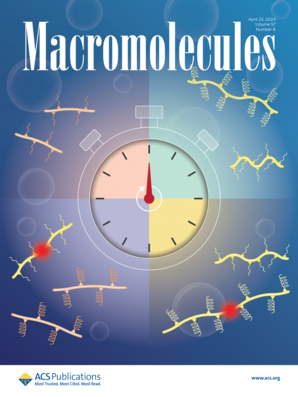Interfacial Tension of Graft Block Copolymers at Immiscible Homopolymer Interfaces
IF 5.1
1区 化学
Q1 POLYMER SCIENCE
引用次数: 0
Abstract
Graft multiblock copolymers are emerging as effective compatibilizers for immiscible polymer blends, leveraging the large parameter space offered by their branched architecture to surpass traditional linear diblock copolymers in compatibilization potential. We report the results of coarse-grained molecular dynamics simulations of AB graft copolymers at a strongly segregated A/B interface, focusing on the impact of graft copolymer loading at the interface and the copolymer architecture on the resulting interfacial tension of the system, which is correlated to copolymer conformation. At relatively low copolymer loadings, distributing the total grafting beads into a greater number of grafts enhances the copolymer interfacial coverage, effectively minimizing unfavorable homopolymer-homopolymer contacts and reducing interfacial tension. At relatively high copolymer loadings, once the interface is saturated with copolymers, molecules with a high number of grafts exhibit a greater penetration perpendicular to the interface, characterized by bending of the backbone and increased deviation of backbone beads from the interfacial plane. Our results demonstrate the existence of an optimal junction density beyond which the copolymers aggregate at the interface, leading to a plateau in interfacial tension as junction density increases further.

接枝嵌段共聚物在非混相均聚物界面上的界面张力
接枝多嵌段共聚物正在成为非混相聚合物共混体系的有效增容剂,利用其支链结构提供的大参数空间,在增容潜力方面超越了传统的线性二嵌段共聚物。我们报告了AB接枝共聚物在强分离a /B界面上的粗粒度分子动力学模拟结果,重点关注接枝共聚物在界面上的负载和共聚物的结构对系统产生的界面张力的影响,这与共聚物的构象有关。在相对较低的共聚物负载下,将总接枝珠分配到更多数量的接枝上可以增强共聚物界面覆盖率,有效地减少均聚物与均聚物之间的不良接触并降低界面张力。在相对较高的共聚物负载下,一旦界面被共聚物饱和,具有高接枝数量的分子在垂直于界面的方向上表现出更大的渗透,其特征是主链弯曲,主链珠与界面平面的偏差增加。我们的研究结果表明,存在一个最佳的结密度,超过这个密度,共聚物在界面上聚集,导致界面张力随着结密度的进一步增加而趋于平稳。
本文章由计算机程序翻译,如有差异,请以英文原文为准。
求助全文
约1分钟内获得全文
求助全文
来源期刊

Macromolecules
工程技术-高分子科学
CiteScore
9.30
自引率
16.40%
发文量
942
审稿时长
2 months
期刊介绍:
Macromolecules publishes original, fundamental, and impactful research on all aspects of polymer science. Topics of interest include synthesis (e.g., controlled polymerizations, polymerization catalysis, post polymerization modification, new monomer structures and polymer architectures, and polymerization mechanisms/kinetics analysis); phase behavior, thermodynamics, dynamic, and ordering/disordering phenomena (e.g., self-assembly, gelation, crystallization, solution/melt/solid-state characteristics); structure and properties (e.g., mechanical and rheological properties, surface/interfacial characteristics, electronic and transport properties); new state of the art characterization (e.g., spectroscopy, scattering, microscopy, rheology), simulation (e.g., Monte Carlo, molecular dynamics, multi-scale/coarse-grained modeling), and theoretical methods. Renewable/sustainable polymers, polymer networks, responsive polymers, electro-, magneto- and opto-active macromolecules, inorganic polymers, charge-transporting polymers (ion-containing, semiconducting, and conducting), nanostructured polymers, and polymer composites are also of interest. Typical papers published in Macromolecules showcase important and innovative concepts, experimental methods/observations, and theoretical/computational approaches that demonstrate a fundamental advance in the understanding of polymers.
 求助内容:
求助内容: 应助结果提醒方式:
应助结果提醒方式:


